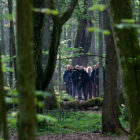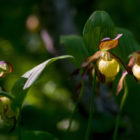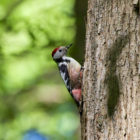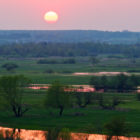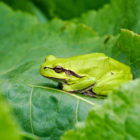Dates & Prices |
BOOK HOLIDAY NOW |
Dates: May – 14th – 21st June 2025 Confirmed departure
Price: £fully booked
Single Room Supplement: £175
Deposit: £200 per person
Price Includes: All meals, accommodation with private facilities, ground transport, services of the guides, holiday report
Not Included: Flights, travel insurance, drinks and any other personal items
Conservation Donation: Butterfly Conservation Europe
Leader: Local guides
Group Size: Minimum of 4 and a maximum of 12 guests plus 1-2 leaders
Grade: Gentle pace. Ideally suited to photography
Holiday Highlights
- Enjoy exploring the Primeval Białowieża Forest and Biebrza Marshes in places you wouldn’t find on your own & spend plenty of quality time out in the wilderness
- Black, White-backed & Three-toed Woodpecker are all possible
- Chance of encountering exciting mammals – European Bison, Elk and possibly even Wolves or Lynx!
- Some special butterflies are likely including Poplar Admiral, Map, Scarce Fritillary, Scarce & Large Heath, Large & Violet Copper!
- Dragonflies! including 4 species of Whitefaces: Yellow-spotted, Ruby, Dark & Lillypad
- Plenty of other good birds to look for – White-tailed Eagle, Black, Whiskered & White-winged Terns, Bluethroat, Greater & Lesser Spotted Eagle, Short-eared Owl, Citrine Wagtail & many more!
- Relaxed pace suitable for photography & full enjoyment of the area for its scenery and wildlife
Explore the primeval landscapes of the Białowieża Forest & Biebrza Marshes!
Białowieża Forest is the last remaining primeval forest in lowland Europe. It covers an area of over 1500 km2 in the tranquil corner of Poland and Belarus. It is home to several rare species of birds, hundreds of insects and thousands of mushrooms. Most importantly, it became the world’s last refuge for European Bison – the largest land mammal on the continent. Centuries old Oak, Elm, Lime and several other species of trees grow here together, in a tremendous variety of habitats. Due to this diversity, age and largely natural structure the forest has been recognised by UNESCO as a Biosphere Reserve and a World Heritage Site. There are over 500 wild European Bison living in the wild in the Białowieża Forest and one morning we will go out early for a safari in search of these impressive animals. we will have a short drive in our minibus to scan the forest edge or go for a walk or even visit a few different sites in a more safari style. We will also walk for a few hours through the strictly protected part of the Białowieża National Park, the Biosphere Reserve and the core area of the UNESCO World Heritage Site. Our trail takes you back in time a few thousand years, when most of Europe was covered with a similar habitat. The dense, natural mixed-deciduous forest of huge, centuries-old trees that host thousands of other species, many of which are on the verge of extinction: insects, lichens and hundreds of colourful fungi growing on dead wood. This area is also home to several species of rare woodpeckers like Black, White-backed and Three-toed and they are often seen here. We might also be lucky to see Pygmy Owl. Large mammals, however, hide very well in the dense vegetation and are rarely seen on this walk, as we mustn’t get off the marked path.This we are sure will be a highlight of the tour as it’s like being transported into a BBC wildlife documentary. An unforgettable experience! Biebrza Marshes are one of Europe’s last natural lowland river valleys. They cover an area of over 1000 km2 of wetlands, peat bogs and bog forests in the far north-east of Poland. Saved from drainage by the non-intensive local farming, these fragile habitats became home for hundreds of rare species of birds, insects and plants that are now difficult to see anywhere else in Europe. This area also holds a large population of Elk (Moose), European Beavers and a few packs of Wolves The Biebrza Marshes are home to a population of over 1000 European Elks (Moose), hundreds of Beavers, rich birdlife, wild flowers and 600 square kilometres of stunning unspoiled landscapes. In the Biebrza Marshes, we will also watch some of the world’s rarest birds such as the Aquatic Warbler. Late May to June is a good time for late birds like Thrush Nightingale, Corncrake, Red-backed Shrike, Red-breasted Flycatcher, Barred & River Warblers, Rosefinch. We should also see an explosion of wildflowers, butterflies, dragonflies and other invertebrates. Biebrza Marshes are also well known for invertebrate diversity. In terms of dragonflies, all 5 European whiteface species (leucorrhynia) can be seen here as well as some spectacular butterflies such as Clouded Apollo, Scarce Fritillary, Scarce and Large Heath and Large Chequered Skipper. This promises to be a fantastic and very popular tour – we recommend booking early to avoid disappointment!




Day 1: Arrival
Pick up from Warsaw and transfer to Biebrza Marshes. After ca. 3 hrs drive we will check in at an comfortable guesthouse in the Marshes. After a hearty Polish dinner the guide will introduce you to the area and talk about the plans. For the next 2 full days (Days 2 and 3) we will be exploring the marshes and the surrounding areas.
If time allows, our guide will offer a short evening walk so you can get accustomed to the area and possibly see some wildlife as Woodlark, Hoopoe, Black Redstart, Great grey Shrike, Black & Grey-headed Woodpeckers are nesting in the neighbourhood, the pond in the guesthouse’s backyard is usually full of “booming” Red-bellied toads and Tree frogs are often found resting in the low vegetation.
Day 2
After substantial breakfast we set of for a journey north into the Middle Basin of the Biebrza Marshes with a stopover at the narrowest stretch of the Biebrza Marshes and take a short walk on a boardwalk leading into some of the finest riverine habitats full of Penduline tits, Bluethroats, Savi’s Warblers and dragonflies such as Common (Ischnura elegans), Small (Ischnura pumilio) bluetails, Spearhead bluet (Coenagrion hastulatum), Yellow-spotted Whiteface (Leucorrhinia pectoralis), Green-eyed hawker (Aeshna isoceles), Blue Chaser (Libellula fulva) and Sedgeling (Nehalennia speciosa) are possible to see among countless Four-spotted Chasers (Libellula quadrimaculata), Variable (Coenagrion pulchellum) and Azure (Coenagrion puella) Bluets.
We will continue our journey further north into the restricted area of the Biebrza National Park, the famous Red Bog Reserve, home for one pack of Wolves. We will spend some time on the glacial sand dunes at the edge of the marsh where we look for Scarce and Large Heaths, Elks and Greater-spotted eagles. Bi-coloured Melampyrum nemorosum grows along side the path while we slowly get up to the top of the dune and we will have our packed lunches there on a viewpoint in the heart of the National Park overlooking the vast marshland.
On the way back we pay a short visit at a picturesque raised bog with its variety of rare boreal flora such as Sundew (Drosera rotundifolia), Labrador tea (Rhododendron tomentosum), Bog bilberry (Vaccinium uliginosum) or Bog rosemary (Andromeda polifolia). This is also excellent habitat for Small Whiteface (Leucorrhinia dubia), one of all five European whitefaces species possible to encounter on this tour!
Day 3
This early morning we will take a short drive for a short walk in the core area of the Biebrza National Park, a boardwalk stretching deep into the marsh full of Aquatic Warblers. Being there so early has other advantages – you will be likely to spot Elks (Moose) as well as several other rare birds including Montague’s Harrier, and experience the magical sunrise over the marshes. Rarities like Greater Spotted Eagle, Short-eared Owl or Citrine Wagtail are also possible to see. Moreover, plant life is very rich here with Bog bean (Menyanthes trifoliata), Purple Marshlocks (Comarum palustre), Early Marsh Orchid (Dactylorhiza incarnata), Yellow Early Marsh Orchid (Dactylorhiza ochroleuca) and many others.
After a hearty Polish breakfast we will take a fascinating walk along the mid-marsh dyke and discover the huge variety of Biebrza’s rare plants, butterflies and dragonflies. Biebrza’s vast fens and peat bogs are mostly inaccessible and off limits but on this walk, you get a chance to go as deep as 4–6 km into the marsh while staying on a dry dyke. You will see a variety of habitats like dry grassland, bog alder forest or fen mire with their rare selection of fauna and flora that can’t be seen anywhere else. It is here where Clouded Apollo, Scarce Heath or Scarce Fritillary can be seen. Many Orchids can also be found, including the spectacular Lady’s slipper or Small butterfly orchid.
Later, we will visit a two more sites, see the flooded meadows full of White-winged, Black and Whiskered Terns, Cranes and a lot more. We will finish the day at a viewpoint overlooking the southern basin of the marshes with good chances of spotting more Elks, terns or eagles.
Day 4
After yet another hearty breakfast we will set off for a full day journey towards the Bialowieza Forest. Actually, it is not that far but we will have several stops at a variety of places on the way for White-tailed Eagles, Penduline Tit, Black and Red-necked Grebes, Whooper Swans, Marsh Terns, Bee-eaters and some fine dragonflies: Lillypad Whiteface and Two-spotted Dragonfly.
Driving through the countryside you will see some traditional wooden architecture and we will also have a chance to stop at one of the many colourful villages for a short walk and a full eastern Poland experience. We shall arrive at our cosy guesthouse in the Bialowieza Forest in time for dinner, after which we will again have a short talk about the plans for the next days over a pint or desserts. The next two full days we will spend exploring the Primeval Bialowieza Forest and the National Park.
Day 5 & 6
At dawn and dusk we will go after wild European Bison, trying to get you close to these magnificent animals. There are over 500 Bison living in the wild here and we have probably the best local knowledge on where to find them. We will travel in our minibus through the forest and go for a few short walks and visit a number of different lookout sites in a more safari style. We may see individual old bulls, small herds of younger animals or large mixed herds of cows with calves. We have seen wild Bison on all our previous trips so far and have had some really close encounters, especially in the autumn and winter.
At midday we will take you further into the wild. You will see some of our favourite trails that wind through a variety of different habitats deep in the centre of the Białowieża Forest. Species seen on such walks include some of the rare woodpeckers, birds of prey or mammals such as Bison or even Wolves and Lynx.
On one of the days in the Białowieża Forest our expert nature guide will invite you for a walk through the only accessible part of the Strict Protection Area of the National Park in Białowieża, the Man and Biosphere Reserve and a UNESCO World Heritage Site. It is a must-see for every visitor in Białowieża.
This trip takes you back in time a few thousand years, when most of Europe was covered with a similar forest. The dense forest of huge, centuries-old trees that host thousands of creatures on the verge of extinction. Our expert guide will share his great knowledge with enthusiasm that will change your view of nature. This excursion will awaken and educate. You will feel as if you have been transported into a BBC wildlife documentary.
Day 7
After an early breakfast we will set off from the Białowieża village for about a 1 hour drive through the Primeval Forest to get to the vast waters, meadows and reed beds of Siemianówka Reservoir. It is not rare that on the way we spot Lesser Spotted Eagle, Great Grey Shrike, Hoopoe and butterflies like Poplar Admiral or Violet and Large Coppers.
Once there we will visit at least 2–3 different sites where our experienced nature guide will take you for a slow paced walk along the marshy banks (dry foot). Birds possible to see include all the three Marsh Terns, White-tailed Eagle, Black Stork, Marsh Harrier, Great White Egret, Penduline Tit and a great selection of Warblers including Marsh and Barred.
We will also pay special attention to all wildlife around. Four species of Whitefaces: Yellow-spotted, Ruby, Dark and Lillypad can be seen over the banks of Yellow Flag while Sand Lizards often bask in the middle of the path.
On the way back we’ll visit one of the most remote places in the Forest – open valley of Narewka river, a very good place for Barred Warbler, Corncrakes, Lesser-spotted Eagles, Poplar Admiral, Map butterfly as well as some fine plants such as Thesium ebracteatum.
Day 8
This morning, after our breakfast we will set off for a ca. 4 hours journey back to Warsaw. The tour ends when we arrive in Warsaw.
Russell T, 2019…
Both of our guides, Tomasz and Alice, were extremely well-informed in a broad range of subjects and Tomasz’s local knowledge in particular was invaluable. Both guesthouses were full of local rustic character and the meals were superb. The sites we visited were well chosen and usually delivered the types of wildlife we were expecting to encounter there. Plenty of time was allowed to enjoy and explore each location and allow whatever creatures that were present there to make their appearance. The small group bonded well and was probably about the right size. A very well-organised and immensely enjoyable tour to a fascinating part of Europe.























